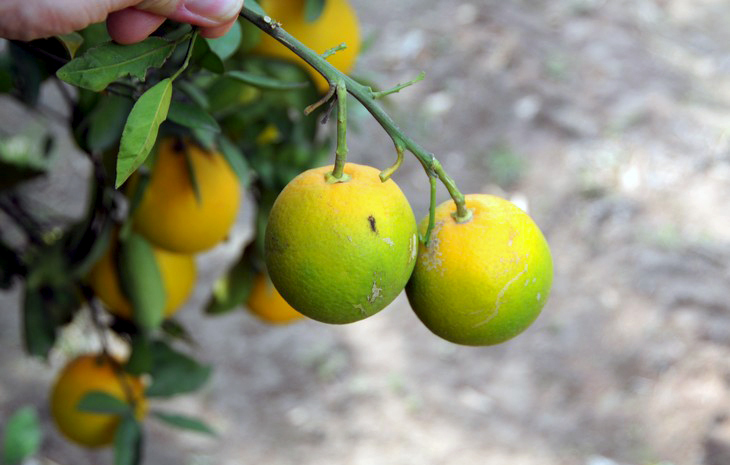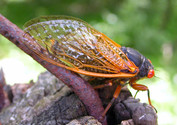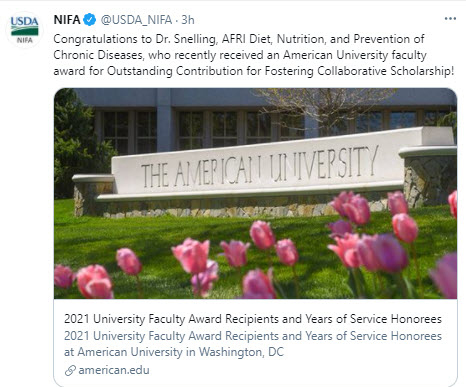|
Having trouble viewing this email? View it as a Web page.

|
|
|
Editor: Kelly Sprute May 12, 2021
Making a Difference
 Citrus greening, a disease that causes green, misshapen, and bitter citrus fruit. Image courtesy of USDA’s Animal and Plant Health Inspection Service’s David Bartels.
CRISPR/Cas Technology Could Enable Early Diagnosis of Devastating Citrus Disease
Penn State University and USDA scientists have used cutting-edge CRISPR/Cas technology to develop a diagnostic test that could enable early diagnosis of Huanglongbing or citrus greening, a serious disease that threatens worldwide citrus production, which is valued at roughly $17 billion from the sale of fresh fruit and juices.
In a new study, researchers demonstrated that the new test detects the presence of the disease's causal agent at a sensitivity level far greater than a commonly used diagnostic assessment. Early detection is crucial since the best hope of reducing the spread of citrus greening is to eliminate diseased trees quickly. Penn State's College of Agricultural Sciences, USDA's National Institute of Food and Agriculture, and USDA’s Agricultural Research Service supported this work. For more information, read the Penn State News article.
|
|

SDA Awards $5.76 Million in Support of Four Centers of Excellence at 1890 Institutions
NIFA announced today an investment of $5.76 million for four 1890 Centers of Excellence grants to 1890 Land-grant institutions.
“The 1890 Centers of Excellence awards are an effort to increase rural prosperity and economic sustainability of food systems in underserved farming communities,” said NIFA Director Dr. Carrie Castille. “These grants will support projects that address critical needs for developing global food security and defense; enhance academic and career activities for students pursuing careers in food and agricultural sciences; and address vital needs in nutrition and health to improve the quality of life of underserved populations.” For more information, read the NIFA press release.
Male college student with laptop, courtesy of Getty Images.
|

NIFA, CDC and Cooperative Extension Team Up for Vaccine Education in Rural America
The Centers for Disease Control and Prevention (CDC) recently provided $9.95 million in funding to the U.S. Department of Agriculture’s National Institute of Food and Agriculture (NIFA) to support an innovative approach to community education and partnerships to advance adult immunization. This is the two agencies’ first concentrated vaccine education effort in rural America.
NIFA will use this funding, provided in an interagency agreement, to support Land-grant Universities and the Cooperative Extension System in delivering immunization education to the communities they serve to improve vaccine confidence. For more information, read the NIFA press release.
Sunflowers in rural America, courtesy of Getty Images.
|

Advancing Efforts to Address Hunger and Food Insecurity
Agriculture Secretary Tom Vilsack explained recent USDA efforts to combat food insecurity and what some of those efforts might look like going forward. USDA’s Rod Bain talks with Agriculture Secretary Vilsack about the food hunger problem in America. For more information, listen to the USDA broadcast.
Image courtesy of Getty Images.
|

Big Bug Invasion Coming to Parts of the Eastern U.S.
Millions of big bugs are expected to invade parts of the Eastern United States very soon. They may ignore social distancing rules. USDA’s Gary Crawford talks with University of Maryland Professor Emeritus and entomologist Michael Raupp about the periodical cicada surfacing soon after 17 years. For more information, listen to the USDA broadcast.
Periodical cicada image courtesy of Getty Images.
|

NIFA Career Opportunities
We are hiring! Remember to check out NIFA's Career Opportunities webpage, where there is a direct link to all open positions. You can also explore NIFA jobs at the USAjobs.gov website. Current openings in Kansas City, Missouri:
Staff Accountant (GS 9-12)
Closing Date: 05/21/2021
|

Turmeric Component May Help Improve Cholesterol, Lessen Statin Side Effects
University of Connecticut Assistant Professor of Kinesiology in the College of Agriculture, Health, and Natural Resources Oh Sung Kwon is working on a grant from USDA’s National Institute of Food and Agriculture to test if a component in the spice turmeric, widely used in dishes throughout Asia and the Middle East, can improve cholesterol levels for people taking statins and alleviate painful side effects. Statins are a class of drugs that can help lower one’s cholesterol and risk for cardiovascular disease morbidity and mortality. The most common reason people reportedly stop taking statins are statin-associated muscle symptoms (SAMS), which include muscle aches, pain, and stiffness. To address this significant side-effect, this study will investigate the possibility of using curcumin, the main active ingredient in turmeric, to treat SAMS. For more information, read the UConn Today article.
Turmeric image courtesy of Getty Images.
|

Students to Create College Health Program
An assistant professor from the University of Maine will lead a study to teach students about community-based health improvement programs. The researchers will then task students with creating one for their campuses aimed at reducing behaviors among young adults that can lead to poor health-related quality of life and increased risk for chronic disease. The course, "Community Based Participatory Research: An Experiential Learning Course to Improve Your Campus Environment," will be open to all students and majors in the fall 2021 semester. USDA's National Institute of Food and Agriculture (NIFA) awarded the project $177,676. The allocation is part of NIFA’s overall $9.5 million investment toward research projects that enhance food and human health and improve diet and nutrition habits to help prevent chronic disease. For more information, read the UMaine news article.
Image courtesy of Getty Images.
|

Grants Help Students Get Ag Research Experience
A new grant at Washington State University (WSU) will allow undergraduate students from WSU, Eastern Washington University, Lewis-Clark State College, and Gonzaga University get real-world agricultural research experience. The Research and Extension Experiences for Undergraduates grant by USDA’s National Institute for Food and Agriculture (NIFA) will put students to work on field research and lab work centered on crops, including visits to farms to talk with agricultural stakeholders. The program will culminate in a final project that students will present to their peers and advisors. Students from all four institutions will be eligible to apply for the project, to be hosted at WSU. The grant, funded for nearly $500,000 over five years from NIFA, will provide undergraduates with income while working and learning. For more information, read the WSU article.
WSU’s Associate Professor Andrei Smertenko. Image courtesy of WSU.
|

New SARE Video “Ecological Pest Management”
Sustainable Agriculture Research and Education’s (SARE) new “Ecological Pest Management” animation highlights how farmers can use natural principles to control pests and improve the health and productivity of their production systems. The fifth episode in SARE’s “What is Sustainable Agriculture?” series introduces key components of ecological pest management and is intended to complement more detailed training materials. For more information, go online to SARE.
|

Reminder: New AFRI Program Priority Area, “Extension, Education, and USDA Climate Hubs Partnership”
Join us for an introductory webinar and Q&A session with national program leaders on May 13 from 2-3 p.m. Central Time. This program area supports projects that provide effective, translatable, and scalable approaches to address climate change through regional partnerships including USDA Climate Hubs and Extension. Go online to learn more or to register in advance for this webinar.
Webinar graphic courtesy of Adobe Stock.
|

U.S. - Ireland Research and Development Partnership - Agriculture Priority Area
The US-Ireland R&D Partnership increases collaborative research and development and maximizes scientific and financial resources, while focusing on mutual strategic research priorities. In 2015, USDA, Republic of Ireland Department of Agriculture, Food, and the Marine (DAFM) and the Northern Ireland Department of Agriculture, Environment and Rural Affairs (DAERA) launched a five-year pilot program adding agriculture as a Partnership priority area. During the pilot the partners capitalized investments in research intended to help solve global agriculture-related issues. Following the successful conclusion of the pilot, USDA, DAFM and DAERA are pleased to include agriculture as a priority area under the partnership.
Join us on June 22 at 10 a.m. EDT | 3 p.m. BST/IST as we discuss the partnership and what is in store for the next phase. If you are a researcher, Land-grant University stakeholder, or simply interested in international agriculture, be sure to join. Go online to learn more or to register in advance for this webinar.
Ireland farmland. Image courtesy of Getty Images.
|

|
|
|
NIFA’s mission is to invest in and advance agricultural research, education, and extension that solve societal challenges. NIFA’s investments in transformative science directly support the long-term prosperity and global preeminence of U.S. agriculture. Keep informed about NIFA, USDA, our land-grant and non-land-grant university partners, and stakeholders with the NIFA Update. Read past issues online, sign up for email updates or follow us on Twitter @USDA_NIFA, #NIFAImpacts or LinkedIn @usda-nifa.
If you wish to submit a news item or information, send an email to NIFAUpdate.
USDA is an equal opportunity lender, provider, and employer.
|
|
|
|